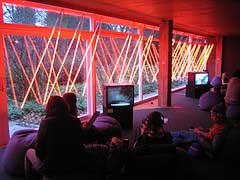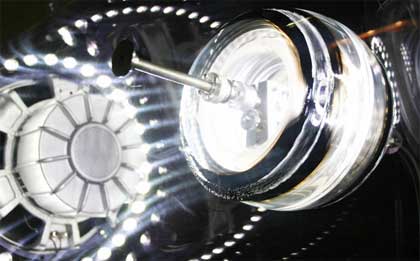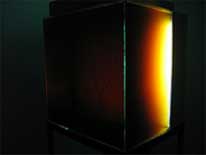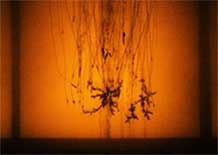 The Transmediale festival opened yesterday evening. The programme lists several interesting partner events, some funky installations at Maria am Ostbahnhof but the exhibition at Akademie der Kuenste is rather unimpressive. Most of the works are good though. What made me unhappy is that the way they are shown is too museum-like, it doesn’t feel like you’re at a lively, edgy new media art festival. The works have loads of space around them which is good if you want the pieces to breathe but too much space makes them look isolated and grief-stricken. Hopefully this will be solved when hoards of visitors will stroll around the exhibition on Saturday. I also wonder if it was really necessary to set the pieces in such a gloomy light.
The Transmediale festival opened yesterday evening. The programme lists several interesting partner events, some funky installations at Maria am Ostbahnhof but the exhibition at Akademie der Kuenste is rather unimpressive. Most of the works are good though. What made me unhappy is that the way they are shown is too museum-like, it doesn’t feel like you’re at a lively, edgy new media art festival. The works have loads of space around them which is good if you want the pieces to breathe but too much space makes them look isolated and grief-stricken. Hopefully this will be solved when hoards of visitors will stroll around the exhibition on Saturday. I also wonder if it was really necessary to set the pieces in such a gloomy light.
But hey, enough ranting (for now).
There are two superb works. I found them so aesthetically magical that i don’t even care whether they are interactive, meaningful or whether there’s any technology involved in their creation.
The first one is Death Before Disko, by Herwig Weiser. The piece uses an online data stream from space observation and translates it into simple yet spectacular sound and light events (i confirm the spectacularity of the light but the one of the sound is quite modest.) I might have more to say about it tomorrow after having heard the artist’s talk at 2 p.m. at the Salon. Video.

The other beauty is a fascinating fluid system with its own life and means of communication. Roots by Roman Kirschner is inspired by an old persian image: a bush growing heads. In an aquarium-like cube filled with a brownish fluid, iron crystals grow steadily. Bubbles ascend like jellyfish. Branches break off and sink to the dark ground. They start to dissolve and become thick clouds hovering over the scene.

 Electricity is pulsed through the sculpture. Growth changes the flow of the current. The modified flow changes the growth. The voltages at each wire are put through a resonance filter and thus transformed into sound.
Electricity is pulsed through the sculpture. Growth changes the flow of the current. The modified flow changes the growth. The voltages at each wire are put through a resonance filter and thus transformed into sound.
The installation is based on the model of a chemical computer by “cybernetician� Gordon Pask in the early 1950s. It was open to the environment and it managed to grow to a configuration which was able to distinguish between different frequencies. Roots refers to a time when the big synthesis and simulation of image, sound, thinking and memory was soon to be started.
First images of the festival.
